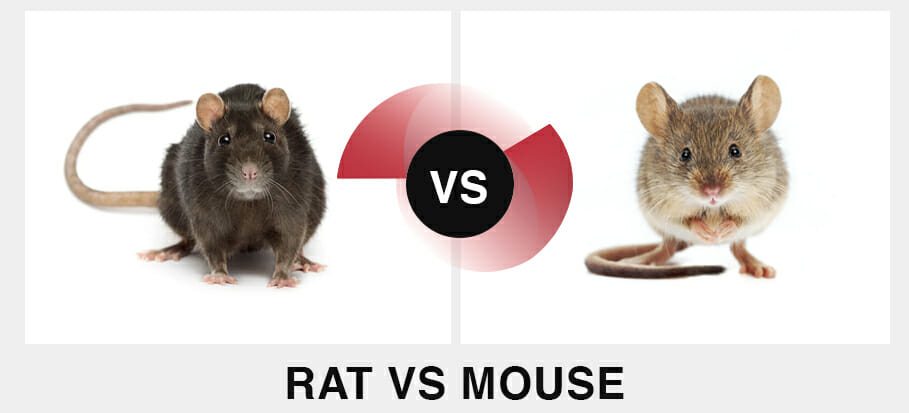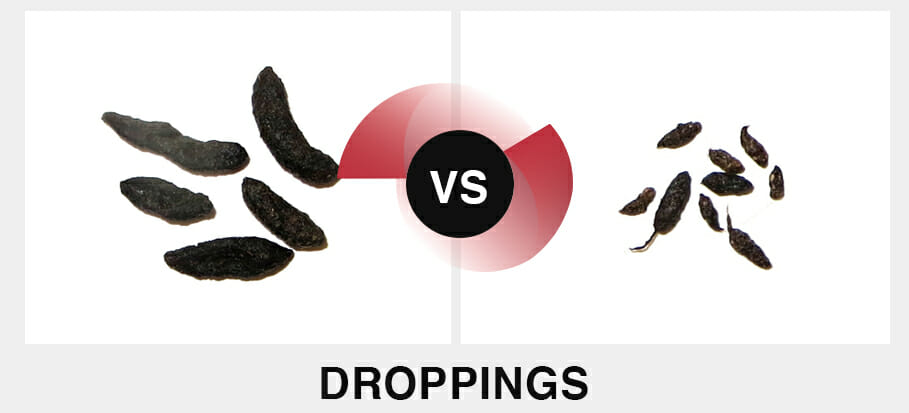Table of Contents
When you notice a rodent in your home, or around your property, most people want to know; is it a rat or a mouse?
They have many similarities, but once you understand the difference, you’ll be able to identify which of the two you’ve seen.
But first, what is a rodent?
“A gnawing mammal of an order that includes rats, mice, squirrels, hamsters and their relatives, distinguished by strong constantly growing incisors and no canine teeth.” – Definitions from Oxford Languages

What is the appearance of a rat vs mouse?
For this article, we are going to focus on the typical brown rat. Brown rats have a thicker body and are much larger than mice. Often, people confuse a mouse with a young rat; however, a mouse will only span 4-10cm in length. Other ways to identify if the rodent is a rat or a mouse is that a young rat will have larger feet and smaller ears.
Brown rat:
- Spans around 15-27cm
- Weight of around 200-300g
- Tail is 10-24cm
Mouse
- Spans around 10-20cm
- Weight of around 12-30g
- Tail is 5-10cm
What is the difference between rat and mouse droppings?
Using droppings as a way to identify which rodent is causing pest issues can be efficient. Rat droppings tend to look extremely shiny and are around 1.27 to 1.9 cm in length, compared to mice droppings which are smaller, softer and have pointed edges.
When inspecting rodent droppings, we recommend using personal protective equipment due to the diseases these droppings carry. Gloves and face masks should be sufficient, and an extra pro tip is not to sweep up the droppings since the diseases can become airborne. Read more information on how to get rid of rats or how to get rid of mice.

How does a rats behaviour differ from a mouse?
If you have mice in your home or garden, you will notice they prefer to feed on cereals, fruits, seeds and grains and on some occasions; they can eat meat. On the other hand, brown rats tend to prefer grains, fish, nuts and meat.
One of the main differences in these two rodents behaviour is their reaction to new objects. Rats in London and other highly populated areas tend to be highly neophobic, which means they have an intense fear of anything new in their area. When a new thing is placed in their area, they tend to avoid them and stay wary for days. Neophobia in rats can make them difficult to catch or poison, and our experience has seen rats avoid traps for weeks on end. On the other hand, mice tend to be more curious and tend to approach new traps and poison to investigate them, making them easier to catch than rats.
Other behaviour differences between rats and mice include their need for water. Mice do not need to drink water. However, if there is water available, they will consume as little as 3ml per day. On the contrary, rats drink 60ml of water per day, making them more reliant on finding a water source.
A rats need for water will often find them living closer to water in larger areas. One of the most common issues we encounter in homes is rats accessing through sewers, which can cause costly damage if the problem is left for some time. On the other hand, Mice will nest in almost any area as long as it is quiet. They’re fantastic climbers and are usually found in attics, walls and under floorboards.
Health problems caused by rats and mice?
Although a rat vs mouse has many differences, they share one similarity with the health problems they transfer to humans. These health concerns include:
- Plague
- Salmonellosis
- Leptospirosis
- Tularemia
None of these diseases is fun to catch, and you want to take all measures to prevent rodents from accessing your property. Rodents can pass on these diseases in the following ways:
- Contaminating food and drink
- Being bitten by a rat or mouse
- Rodent urine
- Faeces
- Breathing airborne diseases
Breeding differences between rats vs mice
The brown rat breeds throughout the entire year, making an initial sighting significant to act upon. In total, the female rat tends to have up to five litters per year, and they can be as large as 14 rats. All of these litters become sexually mature by five weeks and go onto produce their own, showing how a small rat infestation can grow into a large one in no time at all. A shocking statistic taken from newscientist.com is that one pair of breeding rats can produce 15,000 pups in one year alone.
Comparing rats to mice is not on the same level. Mice can produce 7-10 litters per year which contain 4-12 pups. Furthermore, they become sexually active after 4-6 weeks of age, which is a severe issue for those trying to control them. Living indoors allows for breeding to happen all year round.
The lifespan for both of these rodents tends to be around one year; this is less than their life expectancy of three years due to the number of preditors and environmental challenges they face.
Next steps
If you’ve had rodents in your home, you should now be able to know the differences between a rat and a mouse. The following step is to contact a professional pest control company to remove the problem; as mentioned in this article, rats and mice have different behaviours that make them hard to catch and an untrained individual will struggle to remove the problem.
Integrum is the pest control company of choice in London; we’ve performed mice pest control in London and rat control in London to help homeowners avoid the terrible diseases these rodents carry. Alternatively, you can contact us on 020 8914 7894 for some advice.




